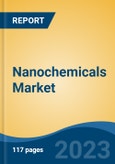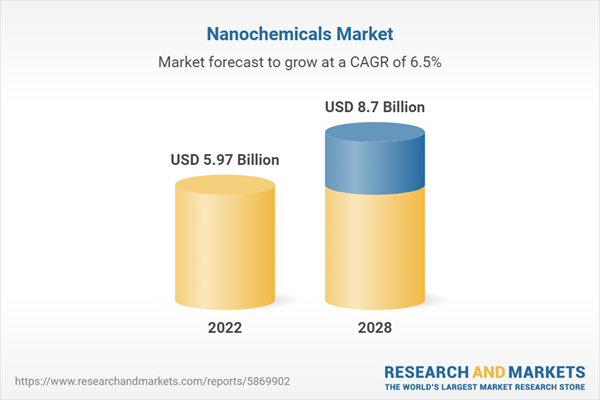Speak directly to the analyst to clarify any post sales queries you may have.
10% Free customizationThis report comes with 10% free customization, enabling you to add data that meets your specific business needs.
Global Nanochemicals market is expected to expand during the projected period due to increasing demand from the pharmaceutical sector as it help to provide advanced drug delivery systems that can target specific cells and tissues. Moreover, nanochemicals are used to produce carbon nanomaterials such as carbon nanotubes (CNT), fullerenes, and graphene which are in demand due to their extraordinary electrical & mechanical properties. In addition, growing applications of these chemicals for producing agrochemicals and cosmetics products further propel the market growth over the forecast period.
Furthermore, several companies and research organizations are investing in the development of new types of nanomaterials and their applications in various industries which further propel the market growth.
For Instance, researchers at the National University of Singapore have developed a new type of nanomaterial called "nanogold," which is made of tiny gold particles that are 50 times thinner than a human hair and has unique optical properties that could be used in applications such as biomedical imaging and drug delivery.
Growing Demand from Pharmaceuticals Sector
The use of various nanomaterials, including fullerenes, dendrimers, and polymer carriers, to transport medication molecules to specific locations within the body is boosting the need for these materials in the industry. Increased usage of these materials in the production of numerous medications are further propelling the market growth.Additionally, by shrinking the size of different medication molecules, nanotechnology-enabled drug delivery has opened profitable potential in the pharmaceutical industry and has improved bioavailability, solubility, and reduced drug toxicity. These applications have expanded beyond medication delivery to include the creation of important drug and medical device formulations with controlled release, which is driving up demand in the industry. Thus, nano-enabled drug delivery help drugs to permeate through cell walls, which is important for the increase in demand for genetic medicines.
For instance, in 2019, a biotech company, Monsanto India, and Bayer announced their merger. With the aid of these two complimentary businesses coming together, consumers would benefit from cutting-edge products.
Therefore, increasing demand for the nanochemicals from the pharmaceutical sector leads to the growth of Global Nanochemicals market in the upcoming years.
Additionally, nanochemicals are used in the food industry for benefits such as improved texture, flavor, and nutritional value. Nano emulsions can be used as delivery vehicles for fat-soluble vitamins, which can improve their absorption and bioavailability in the body. Similarly, nano-sized particles of calcium and iron can be added to food products to improve their nutritional value. Moreover, nanochemicals are also being used to enhance food packaging materials which help to prevent the growth of harmful bacteria and to maintain the freshness of food products.
For instance, Honeywell International has developed a mixture of nylon 6-nanoclay composite (Aegis OXCE) with additional oxygen scavenger property which is ideal for packaging of beer and flavored alcoholic beverages.
Thus, increasing demand of nanochemicals from the food & beverage industry led the market growth in the projected years.
Increasing Demand from Electrical & Electronics Sector
The study of nanoscale systems' electrical and magnetic characteristics is known as nanoelectronics. An important technique that makes use of nanofabrication technology is nanochemicals. The electrical and electronics sector is projected to use these compounds more frequently to create novel materials and products with cutting-edge functionality and high performance. Recent advances in nanomaterials include new methods for creating integrated circuits using transistors made of carbon nanotubes, allowing for transistors with the smallest possible size of a few nanometers.Moreover, chemical-based products with several phases are more in demand as they speed up reactions and generate more products, overall. The demand for these materials will also increase due to their expanding uses in the manufacturing of agricultural chemicals, multifunction coatings with improved durability, and self-cleaning properties. As technology advances and governmental regulations on their production combine with the expanding use of nanotechnology in the chemical industry and new applications of these materials in catalyst design, it is anticipated that industry participants will benefit greatly from increased growth opportunities.
For instance, BASF and KIT jointly developed integrated processes to produce nanostructured functional materials.
Additionally, nanochemicals has wide applications in the cosmetic industry due to their unique features, as well as the advantages of nanoscale ingredients compared to non-nanoscale products. Nanochemicals have a high surface area-to-volume ratio, which makes them highly effective at delivering active ingredients to the skin. They can also penetrate deeper into the skin, providing better results than traditional cosmetics. Nanochemicals improve the stability and efficacy of active ingredients. Though vitamin C is an essential ingredient in many skincare products due to its antioxidant properties, it can be unstable and degrade quickly when exposed to air and light. However, when encapsulated in nano-sized particles, the stability and efficacy of vitamin C can be improved, allowing it to penetrate deeper into the skin and provide longer-lasting benefits. Nanochemicals also be used to create products with improved texture, viscosity, and spread ability, making them more appealing to consumers.
For instance, L’Oréal’s group use nanochemicals to increase the level of sun protection and avoid white marks on skin (by nano titanium dioxide & nano zinc oxide), deliver the best product texture and provide a matte finish on skin (by nano silica), and increase the black intensity in mascara (by nano carbon black).
Furthermore, for instance, Tata Chemicals has developed nano zinc oxide (nZnO) that offers improved anti-fungal, anti-microbial, and UV blocking properties for cosmetic applications.
All these factors drive the growth of Global Nanochemicals market in the forecast period.
Polymer Will be the Key Type
Polymer type nanochemicals with size range of 1-1000 nm, has several benefits, including the potential to be used for controlled drug release in the body, the capacity to shield drugs and other molecules from the biological environment, and enhanced bioavailability and therapeutic index of drug molecules. Companies spending in R&D operations in the field of nanotechnology, which has increased the domain size, such as fuel cell polymer bound catalyst, polymer based biomaterials, self-adhesives polymer films and polymer matrix-based nanocomposites which have wide uses in various applications, resulting in the increase in the demand for polymer based nanochemicals.For instance, Toyota uses polymer nanocomposites in an automotive timing belt cover application.
Thus, increasing demand for polymer based nanochemicals results in the growth of Global Nanochemicals market during the projected period.
However, nanochemicals are known to have unique physical and chemical properties that can pose a risk to human health and the environment. The most important effects of nanochemicals have been found in the lungs and include among others inflammation and tissue damage, fibrosis, and tumor generation. The cardiovascular system may also be affected as nanochemicals may enter the bloodstream from the lungs and translocate to other organs, including the brain. The translocation of inhaled nanochemicals causes them to retain around the respiratory tract regions through diffusional mechanisms, resulting in further medical complications. The inhalation risk is affected by the dustiness of the nano material and the tendency of particles to become airborne in response to a stimulus which restrain the growth of market. Moreover, small size with high surface area and fast reaction mechanism makes it more unstable which results in increasing participation in many biological reactions which had harmful effect on human and environment. The small size of these nanochemicals allows them to pass through different biological barriers and settle in tissues like the central nervous system which affect the nervous system of humans. In addition, the production of nanochemicals involves the use of expensive equipment and specialized manufacturing processes, which increases the cost of production. As a result, the price of nanochemicals is often higher than that of traditional chemicals, which can limit their adoption in various industries which further slowdown the market growth.
Recent Developments
- In February 2023, Scientist at Chalmers University of Technology produced new methods to reveal nano-scale drug molecules in cells.
- Zydex Industries develop Nanotechnology solutions for durable roads in January 2023.
- Coval Technologies produced its first batch of nanotechnology coatings in its Singapore production facility in October 2022.
- In September 2022, Vikas Ecotech signed an MoU with Aurapha Private Limited to start a new plant using nano Calcium Carbonate blended in a conjugated polymer matrix for corrosion protection and a process for the preparation thereof.
Market Segmentation
Global Nanochemicals Market is segmented based on type, application, and region. Based on the type, the market is fabricated into polymer, ceramic, metallic, and others. Based on application, the market is categorized into pharmaceuticals, cosmetics, electrical & electronics, and others. Based on region, the market is divided into North America, Europe, Asia Pacific, South America, Middle East & Africa, By Company.Company Profiles
Alfa Chemical Co., Ltd., BASF SE, DuPont de Nemours, Inc., Merck KGaA, Central Drug House (P) Ltd., Advanced Nano Products Co., Ltd., Evonik Industries AG, Pan-Continental Chemical Co., Ltd., US Research Nanomaterials, Inc., Ad Nano Technologies Pvt Ltd. are some of the key players of Global Nanochemicals Market.Report Scope:
In this report, Global Nanochemicals market has been segmented into the following categories, in addition to the industry trends, which have also been detailed below:Nanochemicals Market, By Type:
- Polymer
- Ceramic
- Metallic
- Others
Nanochemicals Market, By Application:
- Pharmaceuticals
- Cosmetics
- Electrical & Electronics
- Others
Nanochemicals Market, By Region:
- North America
- United States
- Mexico
- Canada
- Europe
- France
- Germany
- United Kingdom
- Spain
- Italy
- Asia-Pacific
- China
- India
- South Korea
- Japan
- Vietnam
- South America
- Brazil
- Argentina
- Middle East & Africa
- South Africa
- Saudi Arabia
- UAE
Competitive Landscape
Company Profiles: Detailed analysis of the major companies in the global Nanochemicals market.Available Customizations:
With the given market data, the publisher offers customizations according to a company’s specific needs.This product will be delivered within 1-3 business days.
Table of Contents
Companies Mentioned
- Alfa Chemical Co., Ltd.
- BASF SE
- DuPont de Nemours, Inc.
- Merck KGaA
- Central Drug House (P) Ltd.
- Advanced Nano Products Co., Ltd.
- Evonik Industries AG
- Pan-Continental Chemical Co., Ltd.
- US Research Nanomaterials, Inc.
- AdNano Technologies Pvt Ltd.
Table Information
| Report Attribute | Details |
|---|---|
| No. of Pages | 117 |
| Published | August 2023 |
| Forecast Period | 2022 - 2028 |
| Estimated Market Value ( USD | $ 5.97 Billion |
| Forecasted Market Value ( USD | $ 8.7 Billion |
| Compound Annual Growth Rate | 6.5% |
| Regions Covered | Global |
| No. of Companies Mentioned | 10 |









